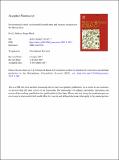Files in this item
Environmental control on microbial diversification and methane production in the Mesoarchean
Item metadata
| dc.contributor.author | Stueeken, Eva E. | |
| dc.contributor.author | Buick, Roger | |
| dc.date.accessioned | 2018-11-14T00:51:03Z | |
| dc.date.available | 2018-11-14T00:51:03Z | |
| dc.date.issued | 2018-01 | |
| dc.identifier | 251537269 | |
| dc.identifier | a5eea795-eb39-43dd-8a0c-f9ff8a6dfaab | |
| dc.identifier | 85034265089 | |
| dc.identifier | 000423651500005 | |
| dc.identifier.citation | Stueeken , E E & Buick , R 2018 , ' Environmental control on microbial diversification and methane production in the Mesoarchean ' , Precambrian Research , vol. 304 , pp. 64-72 . https://doi.org/10.1016/j.precamres.2017.11.003 | en |
| dc.identifier.issn | 0301-9268 | |
| dc.identifier.other | RIS: urn:8179DE9508148FE0F8A8B982095ABDD4 | |
| dc.identifier.other | ORCID: /0000-0001-6861-2490/work/65014408 | |
| dc.identifier.uri | https://hdl.handle.net/10023/16443 | |
| dc.description | We thank the NASA postdoctoral program (EES) and the NASA Exobiology Program grant number NNX16AI37G (RB) for funding. | en |
| dc.description.abstract | Multiple lines of evidence have revealed a thriving marine biosphere capable of diverse metabolic strategies back to at least 3.5 billion years ago (Ga). However, little is known about microbial ecosystems in lakes and rivers during the Mesoarchean and their role in the evolution of the biosphere. Here we report new carbon and nitrogen isotopic data from the fluvio-lacustrine Lalla Rookh Sandstone in Western Australia (∼3.0 Ga) – one of the oldest known non-marine sedimentary deposits. Organic δ13C values (-30‰ to -38‰) are best interpreted as recording carbon fixation by methanogens using the acetyl CoA pathway mixed with organisms using the Calvin cycle, while δ15N data (0‰ to -1‰) likely reflect biological N2 fixation using FeMo-nitrogenase. When compared with data from the literature, we show that lacustrine habitats of Mesoarchean age (3.2-2.8 Ga) are systematically depleted in δ13C (-37 ± 5‰) relative to marginal marine (-32 ± 7‰) and open marine settings (-27 ± 3‰), suggesting that methanogenesis was relatively more important in lacustrine communities. Our findings highlight: (a) the widespread use of biological N2 fixation by the Mesoarchean biosphere, (b) the potential importance of continental habitats for methane production and perhaps for the formation of hydrocarbon haze, and (c) the possible role of land masses in driving microbial diversification on the early Earth. | |
| dc.format.extent | 1777167 | |
| dc.language.iso | eng | |
| dc.relation.ispartof | Precambrian Research | en |
| dc.subject | GE Environmental Sciences | en |
| dc.subject | QE Geology | en |
| dc.subject | NDAS | en |
| dc.subject | SDG 14 - Life Below Water | en |
| dc.subject | SDG 15 - Life on Land | en |
| dc.subject.lcc | GE | en |
| dc.subject.lcc | QE | en |
| dc.title | Environmental control on microbial diversification and methane production in the Mesoarchean | en |
| dc.type | Journal article | en |
| dc.contributor.institution | University of St Andrews. Earth and Environmental Sciences | en |
| dc.contributor.institution | University of St Andrews. School of Earth & Environmental Sciences | en |
| dc.contributor.institution | University of St Andrews. St Andrews Centre for Exoplanet Science | en |
| dc.identifier.doi | 10.1016/j.precamres.2017.11.003 | |
| dc.description.status | Peer reviewed | en |
| dc.date.embargoedUntil | 2018-11-14 |
This item appears in the following Collection(s)
Items in the St Andrews Research Repository are protected by copyright, with all rights reserved, unless otherwise indicated.

